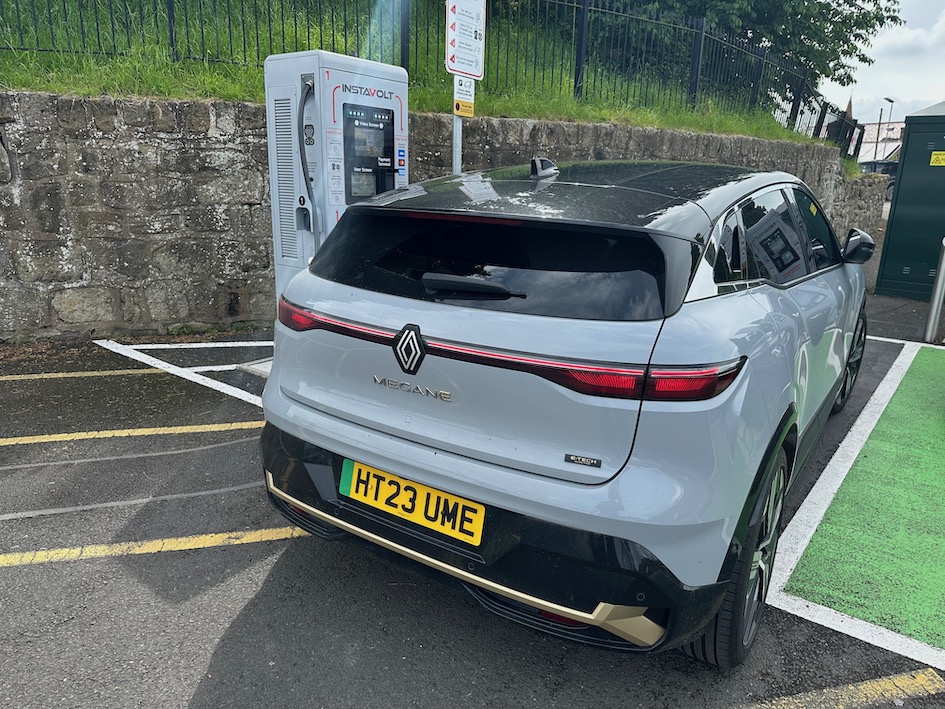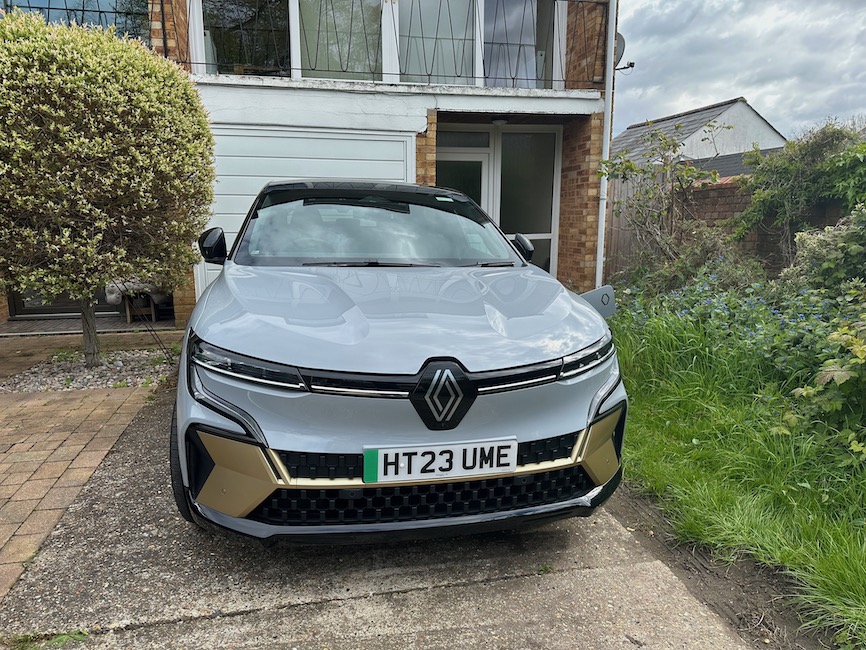REPORT 4

Do you prefer to stick it in the front or the rear?
Your EV’s charging point I mean. It’s a question I’ve been thinking about a lot recently, especially when publicly charging the Renault Megane E-Tech. In the two months we’ve been driving the Megane, I’ve managed to rack up just over 2700 miles, which considering normally I have a short commute, isn’t too bad.
That average is only going to get higher too, with more trips to Wales to continue (and finish) my Offa’s Dyke walk and two trips to Devon and Cornwall planned over the summer. And all of that is with public charging too – and I’ve already been getting familiar with the chargers on the way to North Wales.
The Megane’s charging port is on the nearside front wing meaning you often have to drive forwards into a charging space. It’s not the end of the world, but still frustrating if, like me, you prefer to back into spaces. But then, because it’s on one side, rather than centrally on the grille like a Renault Zoe or MG5, you can end up having to drag a heavy CCS cable over the bodywork.
Interestingly, one EV Point ultra rapid charger rather helpfully got round this problem with a handy extendable supporting arm for the cable, but for other chargers it was still an issue. One on Instavolt I ended up having to sit partly out of the parking bay to ensure the cable reached.
Renault claims up to a 130kW charging speed for the Megane E-Tech, but we’ve never seen more than 79kW from any of the ultra rapid 120kW chargers we’ve been using recently. However, it’s hard to tell if that’s the fault of the car or the chargers.
It does expose the Megane’s relatively small 60kWh battery on longer journeys though. At motorway speeds the range is closer to 180-190 miles, meaning on longer journeys by 150 miles you’re thinking about charging and by 160 it starts to become more pressing, especially if you want to find a reliable ultra-rapid.
And then for longer journeys, as I’ve been doing recently, it means you need to charge close to 100% for the return journey. As any EV driver will tell you too, any EV will rapidly charge up to 80%, but the 80-100% can be painfully slow. A larger battery like the VW ID3’s 77kWh or even the 87kWh in the larger Scenic would help to open up your options so much more.
For the moment however, I’m just enjoying racking up the miles on the Megane in whatever way I can. So much so, that it’s just told me a service is now due, so that’s the next job on the list.
REPORT 3

This column on my long-term Renault Megane E-Tech is going to be something of a maths lesson. But before you break out into a cold sweat worrying about trigonometry, algebra and whether your old mean teacher is going to give you six of the best for eating gobstoppers at the back of the class, I don’t mean that kind of maths lesson.
Instead, I mean an EV charging maths lesson. I’ve been doing some long journeys in my Megane recently as I continue my Offa’s Dyke walk. Unfortunately though, that means a very early start, a reasonably long 175-mile drive, followed by a 15-17 mile walk and another 170-mile drive home again. And no, I don’t really know why I’m putting myself through it either, something about it being there and the challenge.
The challenge is made even greater by the fact that those 350 miles are substantially beyond the Megane’s maximum range, particularly so at motorway speeds. The good news came in the form of some 120kW Instavolt ultra-rapid chargers in Oswestry. The bad came in the fact that the 170 mile drive, plus the fact that the Megane E-Tech mysteriously lost 6% of charge while parked for 6 hours, meant I rolled up to the charger with just 2% of charge remaining – rather too close for comfort.
Needing almost a full charge to return home meant I pumped a fraction over 58kW into the Megane over an hour – at a hefty cost of £49.61. No, it wasn’t cheap, but it got me back home where I can obviously charge up for cheaper and where I started doing some maths. Currently at home, I’m on the standard tariff of electricity at 24.5p/kWh meaning a full charge at home costs me £14.70, giving me a total for the round-trip of £64.31. I actually returned home with 9% of charge still in the car, but for the sake of simplicity, we’ll call it two full charges.
However, if I had managed a full charge at home on Intelligent Octopus Go at 7.5p/kWh that would have been just £4.50, reducing our round trip total to £54.11.
Now, let’s do the same for a petrol car. At £1.43/litre and 40mpg, that’s just over 39.725 litres and a total of £56.80, so not far above that reduced charging figure. However, we charged our Megane for half of the journey at one of the most expensive charging locations, so the equivalent in petrol terms would be a motorway services.
But we’re also fair that our home charging, especially with Intelligent Octopus Go, is the cheapest around. So if we filled up at a supermarket petrol station for the outbound journey, those two combined would come to £61.56, so more than the equivalent off-peak charging, but less than £3.00 less than what we actually paid.
Of course, those fleets running electric cars with account cards such as Octopus Electroverse get reduced rates too, but hopefully these calculations will show that you always need to compare like with like and why home off-peak charging at reduced rates is always the best option for fleet managers.
Right, now pass the gobstoppers, quickly while the teacher isn’t looking…
REPORT 2

If I’m being entirely honest, I was expecting it to take longer. The past six months saw me at the wheel of a Mazda CX60 and, while I didn’t always enjoy its size when parking, I did appreciate its internal dimensions when moving people or trips to the dump.
So I felt that switching to the Renault Megane was always going to be a challenge. Firstly because of its size and secondly, because it was fully-electric. Don’t get me wrong, I generally welcome the move to EVs with open arms, it’s just that circumstances mean that I’m temporarily living in a house without an EV charger, so all my charging needs to be done publicly or on a granny lead – far from ideal.
I’ll touch on the cost implications of that – and the advantages of an EV compared to a traditional ICE car – in my next column, but needless to say, I shouldn’t have worried. The Renault E-Tech has been a perfect demonstration of usability and practicality. As the ambient temperature has improved, so has my fully-charged range, creeping upwards from a worrying 193 miles when it first arrived to a heady 253 miles at one point. An average of around 235 miles seems to be the norm and closer to a real-world figure.
Yes, that’s still short of the official 280 miles, but in reality, I don’t usually do more than that in a day, so it’s hardly an inconvenience. Would we like the Megane E-Tech to be available with the option of a larger battery, as with the 87kWh in the Scenic? Yes, but whether buyers would stomach the £3500 price difference as with that car is another matter.
On the upside, the Apple Carplay connection seems to be behaving itself in the Megane compared to my last report, even if I connect it with a USB cable rather than by Bluetooth. That’s not really a problem as I’m not a fan of the induction charging pad on front of the Renault’s dashboard anyway.
A new source of ire though has been the Renault’s door mirrors or, more precisely, the design of their mounts. It’s a niche problem admittedly, but their squared off design clearly leads to a slightly odd airflow around the front lower corner of the door windows. Not a problem in the dry, but when driving in rain on the motorway, the airflow then swirls round and constantly spatters the corner of the window just where you look in your door mirror.
It may sound like a nit-picking problem, but when driving, the way these constant droplets catch the light make them seem like movement in the door mirror, meaning you find yourself checking them far more than normal to ensure there’s nothing really there. I’m hoping it’s a dry summer ahead , so that I don’t have this problem too frequently.
REPORT 1

If Renault’s name was already good in the world of EVs thanks to the legacy of the popular Zoe, then it’s fair to say that 2024 will probably see that boosted still further.
The unveiling of the retro-styled new Renault 5 will be at the forefront of that, but so will the arrival of the all-electric Scenic running alongside this Megane E-Tech which joins the Fleet World long term fleet for the next six months.
Looking mean and moody in its optional Cermanic Grey bodywork and black roof with gold accent trimmings on this flagship Iconic model, it certainly looks the part. In fact, while I’d got used to larger SUVs with my outgoing Mazda CX60, this Megane feels small by comparison, but that’s very welcome in tight car parks.
Still that’s no bad thing with its 60kWh battery, which at first sight feel a little on the small side, compared to the VW ID3’s 77kWh, but the claimed 280 mile range is still respectable. The larger Scenic gets the choice of the same 60kWh battery or an 87kWh long range battery too.
Would it be good to have the same choice in the Megane? Perhaps, but with a claimed efficiency of 3.86mls/kW, there’s a strong argument for ‘right-sizing’ of batteries in cars and first impressions of the balance in this Megane are that this might be ok. Just.
I especially like the low and sleek look, accentuated by that black roof, although the only thing narrower than the rear windscreen is the opening on Editor Challen’s wallet when it’s his round. The look out of the rear view mirror is like peering out of a letterbox and the rear wiper is comically tiny.
It’s only been with us a few days so far, but I like the ability to quickly switch the level of regenerative braking on the steering wheel paddles (something that should be obvious, but isn’t always) as well as the consistency of the feedback. Not so great has been the infotainment system which seems oddly random to successfully link to Apple Carplay and the screen which feels oddly small compared to rivals. I’m looking forward to coming back to this, and the other highs and lows of the Megane, over the next six months.

